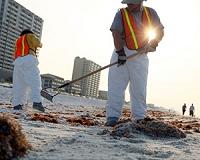| . |  |
. |
Bhopal, India (AFP) June 9, 2010 India's justice system took 25 years to deliver a verdict on the company executives blamed for the 1984 Bhopal gas disaster, but the pollution clean-up operation is taking even longer. On Monday, seven managers from the local subsidiary of US chemical group Union Carbide were sentenced to two years in prison for criminal negligence in the first convictions in the case. They will appeal and were released on bail. The sentences, perceived as too lenient by rights groups and survivors, have shone a spotlight on simmering grievances at the way the disaster was handled by the company and authorities. Union Carbide settled all liabilities related to the accident, including the clean-up costs, with a 470-million-dollar out-of-court deal with India's government in 1989, after years of wrangling about the amount. Ever since, campaign groups, environmental groups and scientists have warned that local authorities have never adequately sanitised the site, meaning toxins continue to cause illnesses and birth defects among residents. "Nobody wants to clear the poison that is lying in the yard and all our protests demanding safe disposal have failed," said Satinath Sarangi, a member of a voluntary medical organisation, Sambhavna, in Bhopal. The disaster began on December 3, 1984, when the Union Carbide pesticide plant in the central Indian city accidentally released about 40 tonnes of toxic gas into surrounding residential areas. According to the government, 3,500 lives were lost in the immediate aftermath but activists and rights group calculate that 25,000 people died in the years that followed. A year after the gas leak, the local authorities collected 350 tonnes of waste and left it in the factory yard, ignoring all safe waste management practices. In the past two decades, several studies have concluded that the material containing toxins and heavy metals has leeched into the ground, contaminating groundwater --- the only source of drinking water for 20,000 people nearby. A 2004 high court order requiring the state government to clean up the waste has resulted in only partial clearance. A study by Indian non-profit organisation the Centre for Science and Environment (CSE) last year showed groundwater three kilometres (two miles) from the plant contained 110 times the maximum quantity of the pesticide carbaryl deemed safe in Indian bottled water. "The factory site in Bhopal is leading to chronic toxicity -- continuous tiny exposure leading to poisoning," said the director of the CSE, Sunita Narain. The local government in Madhya Pradesh, of which Bhopal is the capital, acknowledges the waste is still there. "For years the matter was in the court and we could not clean the Union Carbide premises, but now we have a green signal to dispose of it," R.K. Jain, a senior member of the Madhya Pradesh Pollution Control Board, told AFP. Jain said 350 tonnes of waste would be incinerated at a disposal facility by September this year. "We are conducting experiments to check if our incineration plant is working well. If there is no problem, then we will get rid of the waste by September," he said. For some the government is to blame for dragging its feet on the waste disposal, despite a ticking public health time-bomb. Others see Union Carbide as shirking its responsibility to clean up after itself. "It is the failure of the Indian government for not being able to get Union Carbide to do the clean up," says Abhishek Pratap, a campaigner at Greenpeace. "They should have collected the waste and secured it in concrete chambers." The company says all of its liabilities were covered by the out-of-court settlement. In the meantime, at least 100,000 people living near the factory suffer from chronic illnesses, with more than 30,000 living in areas with contaminated water, according to government figures. People there remain convinced they are still at risk. "The waste has killed more people than the total number of people killed on the incident night," said Savitri Mahe, who lost her 16-year-old daughter to the leak. "I drink the toxic chemicals that killed my daughter."
Share This Article With Planet Earth
Related Links Our Polluted World and Cleaning It Up
 Oil will damage southern US coast for years
Oil will damage southern US coast for yearsWashington (AFP) June 7, 2010 The long-term effects of the Gulf of Mexico oil spill will damage fragile ecosystems for years to come, US officials said Monday, as engineers successfully captured more crude from a broken wellhead. "Dealing with the oil spill on the surface will go on for a couple of months," said Admiral Thad Allen, who is coordinating the government's response to what has been called the worst environmen ... read more |
|
| The content herein, unless otherwise known to be public domain, are Copyright 1995-2010 - SpaceDaily. AFP and UPI Wire Stories are copyright Agence France-Presse and United Press International. ESA Portal Reports are copyright European Space Agency. All NASA sourced material is public domain. Additional copyrights may apply in whole or part to other bona fide parties. Advertising does not imply endorsement,agreement or approval of any opinions, statements or information provided by SpaceDaily on any Web page published or hosted by SpaceDaily. Privacy Statement |